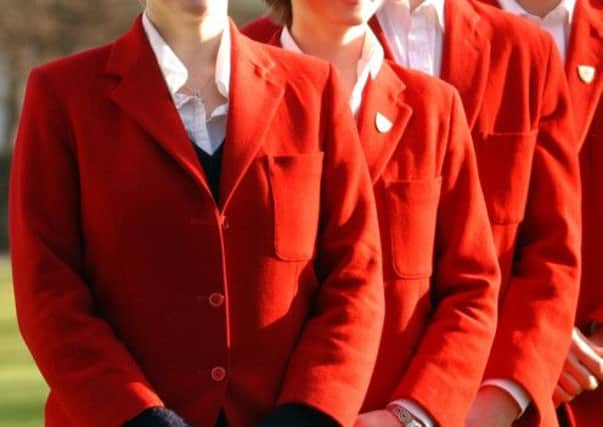Private schools ‘must do more’ for poor pupils


An investigation by Scotland on Sunday found many of the country’s leading independent schools provide full bursaries for fewer than 1 per cent of the school roll – often just one or two pupils a year.
The figures were collated from reports written by the Office of the Scottish Charity Regulator (OSCR), which assesses the schools for the public benefit they provide.
Advertisement
Hide AdAdvertisement
Hide AdWhile private schools often set aside significant parts of their budget for means-tested bursaries, very few children receive support which covers 100 per cent of their tuition.
The findings come after former prime minister John Major warned earlier this week of the “truly shocking” dominance of the privately educated in British public life. His comments were backed by Eton-educated Prime Minister David Cameron, who said more had to be done to improve social mobility.
The charity regulator is currently investigating private schools in Scotland to establish whether they are providing enough public benefit for the tax breaks which they are accorded under their charitable status.
While the number of children receiving bursaries is likely to fluctuate from year to year at individual schools, the reports published by the regulator so far – which cover around half of Scotland’s 53 private schools – show that in certain years some schools failed to offer free tuition to a single pupil.
When investigated in 2011-12, Craigclowan Preparatory School in Perth, which currently charges fees of £10,710 a year, did not have a single pupil receiving an award in excess of 80 per cent of the school’s fees.
When visited in 2012-13, Kilgraston, a girls’ school which charges up to £15,000 a year for day pupils, did not have any pupils receiving a 100 per cent bursary. However, the school did have three pupils receiving full fee remission through a combination of the school’s award and an award from an external trust.
Last month the OSCR warned Loretto School in East Lothian that it could be stripped of its charitable status after an investigation found it had “insufficient measures” in place to widen access for pupils from poorer backgrounds. According to the regulator’s report, there was only one child at the school in 2012-13 – a lower sixth form pupil from eastern Europe – who received the full cost of fees, which came in the form of a Headmasters’ & Headmistresses’ Conference (HMC) Scholarship.
Labour’s education spokeswoman, Kezia Dugdale, said it was time for independent schools to improve access for the poorest in society: “Our private schools, just like our universities, must do more to expand inclusion and justify their charitable status.”
Advertisement
Hide AdAdvertisement
Hide AdLib Dem education spokesman Liam McArthur added: “Giving the chance for our children regardless of background to get on in life should be the aim and ambition across our education sector.
“In that light, private schools may wish to reflect on whether or not they are doing as much as they can to give children from poorer backgrounds the opportunities they deserve.”
In the years they were visited by the regulator, schools including Belmont, in East Renfrewshire, and Wellington, in Ayr, had just one pupil on full support – equivalent to less than 0.5 per cent of the school roll.
According to the OSCR’s figures, the school with the most children on full means-tested support was Beaconhurst School in Bridge of Allan, Stirling, where 13 pupils were given a 100 per cent bursary in 2011-12 – 4 per cent of the school roll.
Schools including Glenalmond, Belhaven Hill, Clifton Hall, Kelvinside, Fettes, Strathallan and St George’s had fewer than 1 per cent of pupils on full bursaries when visited by the regulator. In 2011, four private schools – Hutchesons’ Grammar, in Glasgow, Merchiston Castle, in Edinburgh, Lomond School, in Helensburgh, and St Leonards, in St Andrews – were allowed to keep their charitable status after a three-year investigation by the regulator. The OSCR said the probe had “significantly” widened access to the schools.
About one in 20 children in Scotland is educated at private schools, although the Edinburgh figure is closer to one in four. The figures for bursaries are roughly in line with England, where 4,287 pupils (0.84 per cent of the total) receive full support with their fees.
Scottish Conservative young people spokeswoman Liz Smith said: “All schools in the sector have made a strong commitment to expand bursary provision and to provide more places for pupils from lower income families.
“Last year there was around £35 million available to support discounted fee places in private schools and the vast majority of that money was used to provide means-tested bursary support for lower- income families.
Advertisement
Hide AdAdvertisement
Hide Ad“It is a matter for the individual school to decide how it allocates bursary support, but in cases where OSCR has ruled that the charity test has not been met, schools are required to revise their policies. This is as it should be.”
John Edward, director of the Scottish Council of Independent Schools (SCIS), said: “The amount of money given away [in bursaries] has gone up exponentially in recent years – that is the figure to focus on.
“One of the things OSCR is very strong about is how you advertise the bursary provision because the money is useless unless people know it’s there. But if you don’t have applications from people who are eligible for 100 per cent bursaries, you don’t give them away.
“Schools are keen to widen access, but there’s a limit to the amount of people that are interested.”